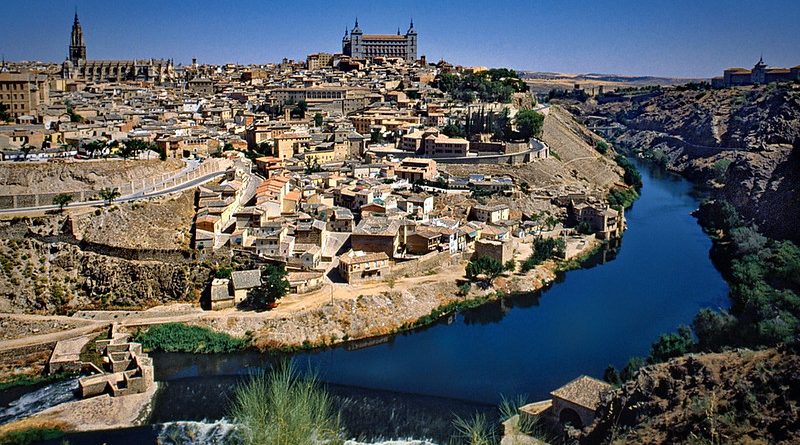The Spanish Empire
Lasting nearly five centuries, The Spanish Empire was, at its peak during the 16th, 17th and 18th Centuries, the world’s most prominent global power, earning the nickname ‘The empire on which the sun never sets’. While its global supremacy was eventually eclipsed by the ascendant British Empire, the Spanish Empire remains one of history’s most important global powers, known as much for its military dominance as it was for its controversial actions and intrigues.
Ferdinand & Isabel
The Spanish Empire’s beginnings, on a macro level, are often considered to originate with the dynastic marriage between Ferdinand of Aragon and Isabella of Castile, who became known as the ‘Catholic Monarchs’. This unification established a sense of religious and social harmony, with Catholicism providing an effective gel between the Iberian Kingdoms. In spite of this, the Kingdoms remained politically distinct entities, retaining their specific customs and administrative practices. Isabel’s Kingdom of Castile was the more dominant of the two, due to its growing influence overseas and the natural resources it reaped from its territories.
Columbus
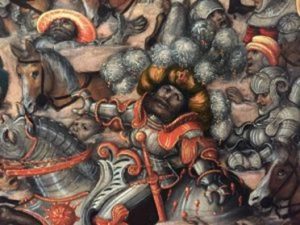
The ascendancy of the newly-unified ‘Catholic Monarchs’ coincided with the exploits of famed explorer Christopher Columbus. An Italian financially supported by the Spanish Crown, Columbus’ four voyages are credited with the establishment of European colonisation of the New World, which of course, had far-reaching repercussions across several centuries. The Westward voyages were initially motivated by the a desire to establish new trade routes with the East Indies, and undercut competition with other European powers. However, Columbus’ discovery instead ushered in a long, and devastating period of exploration, colonisation and genocide throughout the Americas. His actions, on the behalf of the Catholic Crown, are often credited by modern historians as establishing the Transatlantic Slave Trade, while he himself viewed his ‘accomplishments’ as missionary in nature, spreading the values of Catholicism. Columbus’ voyages and their impact are credited with significantly contributing to the formation of the modern Western World.
The Conquistadors
While Columbus cannot be entirely credited with establishing the drive for overseas conquest, his discoveries can certainly be credited for its intensification. Following his voyages to the Americas, the Spanish Empire accelerated its exploration and subsequent conquest of the New World. The label ‘Conquistador’ is a broad one and it predated the Columbus-inspired period of territorial expansion. However, generally speaking, ‘The Conquistadors’ refer to the forces who unleashed the conquest of the Americas on the behalf of the Spanish Empire. Two figures are particularly synonymous with this term, Hernan Cortes and Francisco Pizarro, for their conquests of the Aztecs and the Incas respectively.
Despite few sources existing, which shine light on Cortes’ personality or motivations, he remains one of the most important figures in the history of the Spanish Empire. Not born into a particularly noble family, this is believed to have a bearing on Cortes’ actions and abilities. He began his expedition into Mexico after arriving in Cuba with Diego Velasquez de Cuellar, an aide to the Governor. The two had a strained relationship, which reemerged after Cortez had been dispatched to Mexico by Velasquez, who ordered him to return. A maverick figure, Cortez ignored his orders and set sail, with 500 troops and 11 ships in tow. Enlisting the aid of a shipwrecked priest Geronimo de Aguilar, who proved an effective translator, Cortes was eventually able to ally himself with some of the native populations, whilst laying waste to others. Following military victories over the Cholula and Tlaxacan Warriors, he marched for Tenochtitlan, the capital and central hub of the Aztec Empire, with designs on conquering it outright. He held its ruler Montezuma II captive whilst his soldiers conquered and pillaged the city, retreating upon hearing Spanish soldiers were closing in on him for his mutinous actions. Briefly coming into conflict with the Spanish, from which he emerged victorious. Following an Aztec rebellion triggered by The Massacre in the Great Temple, Cortez fled, returning in 1521 to conquer the city, which saw him appointed Governor of New Spain by King Charles I and the annexation of Mexico begin. Cortez’s success was short-lived, and he was unceremoniously removed from his position, returning to Spain in 1540, dying seven years later, an embittered and broken man.
Francisco Pizarro, the Conquistador of the Incan Empire, grew up in far more lowly conditions than Cortes, spending his childhood illiterate and in poverty, but nonetheless became one of the Empire’s most accomplished and ruthless explorers. Gaining important experience in less fruitful voyages to the Caribbean and Panama, he convinced Charles I to commission and finance an expedition to the Southern Americas. Two expeditions in 1524 and 1526 ended in failure, while a third in 1528 saw him return to Spain with an abundance of precious metals. He returned with the approval of the King, and came into conflict with the Incan ruler Atahualpa, who was captured and executed after having extorted a considerable ransom from his followers. He completed his conquest of the Incan Empire after overcoming its capital Cuzco, founding the new capital Lima shortly thereafter. Pizarro’s immense military successes were short-lived, as internal divisions intensified into outright conflict. His former ally Diego Almagro led a faction against Pizarro, culminating in the Battle of Los Salinas, with Pizarro emerging victorious and Almagro executed. In retaliation, Pizarro was assassinated by Almagro’s son in Lima.
Gold, Silver & The Galleon Trade
The Spanish dominance over the Americas proved to be a significant source of the Empire’s wealth. This was achieved through the export of a number of materials unavailable in Europe, most notably precious metals such as silver and gold. Mines were established throughout the Americas. It is estimated that by the end of the 16th Century, silver from the Americas accounted for around 20% of the Spanish Empire’s total budget. The prevalence of silver from the Americas caused precious metals’ stock to triple. The lucrative precious metal trade was a significant factor in galvanising Europeans to settle in the Latin American colonies. The Manila Galleon became a critical trade route for the Spanish precious metal trade, linking the Filipino city of Manila with the Port of Acapulco in Mexico. This trade route saw precious metals exchanged for luxury goods from the Old World, whilst also creating a cultural exchange between the two colonies which continues to resonate today. The precious metal trade was a pivotal part of the Spanish Empire’s economic strength, and their loss of the colonies from which these metals were mined had clear devastating financial effects.
Charles I & The Holy Roman Empire
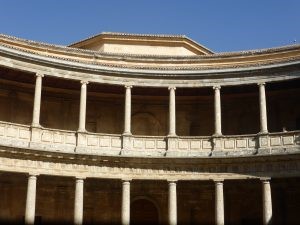
Charles Ist Palace in Alambra
The heir to three of Europe’s most powerful dynasties, Charles I or Charles V is widely considered to be the first titular King of Spain as the first simultaneous ruler of Aragon and Castile. Additionally, Charles inherited rulership of the Holy Roman Empire through the Habsburg Monarchy. As a result, Charles I of Spain or Charles V, Holy Roman Emperor had become Europe’s most powerful monarch and the continent’s closest thing to a universal monarch in centuries. Charles’ immense power and territorial dominance triggered spikes of hostility from his rivals. These rivals feared that Charles would pursue a universal monarchy. As a result, his reign was dominated by recurring conflicts. The most prominent of these were with the French, the Ottomans and the German Princes. These conflicts often overlapped with one another, greatly defining his reign.
His conflict with the French, otherwise known as the Habsburg-Valois Wars, themselves a part of the broader Italian Wars. These conflicts proved to be particularly financially draining upon Charles I. Despite repeatedly recovering lost territory and at one point defeating and capturing Francis I of France, the wars persisted until the end of his reign. Charles’ conflict with the Ottoman Empire was waged primarily in Hungary and the Mediterranean. The war was waged on the behalf of his younger brother Ferdinand I, the King of Hungary, and lasted for the bulk of his reign.
Charles’ conflict with the German Princes was based on religious tensions between Catholicism and Protestantism. Fears about Charles’ monopoly of power over Europe were conflated with concerns about the Catholic homogenisation of the continent while Charles himself was hostile towards the Reformation and spread of Protestantism. While he was successful against the German combatants on a military level, he was unable to curb the spread of Protestantism throughout Europe.
Furthermore, his reign was plagued by rebellions of varying severity. Revolts in Castille and Ghent were particularly troublesome, although they were stamped out.
Charles ultimately abdicated from power, exhausted by decades of near-constant conflict. He ceded control of the Holy Roman Empire to his younger brother Ferdinand and the Spanish Empire to his son Phillip II. The two Empires remained closely linked as allies for centuries, but the monopoly that generated so much hostility during Charles’ life was over.
The Low Countries
Otherwise referred to as the Spanish Netherlands, the Low Countries played a pivotal role in the history of the Empire. Now better known as the modern-day Benelux region, the Low Countries were known for being an arena of conflict during the tumultuous Spanish Empire. Its geographical location ensured it was the stuck between Catholic and Protestant states. Furthermore, the region was often the source of outward rebellion against the Empire, triggered mainly by the arrival of Calvinist Protestantism and a rejection of Catholicism. The fast-growing Protestant movement became conflated with a desire for autonomy from the Catholic Spanish Empire. In spite of this, the Low Countries remained an economically prosperous region throughout the 16th and 17th Centuries through agricultural innovations such as canal-digging. The region also became a significant cultural hub, the cities of Ghent and Bruges being particularly important. The region also enjoyed a degree of political autonomy. The constant surrounding conflicts ultimately curtailed this prosperity, and the Low Countries were ultimately divided up between the Austrian Habsburgs and the Holy Roman Empire, bringing the era of the Spanish Netherlands to an end.
The Habsburg Dynasty
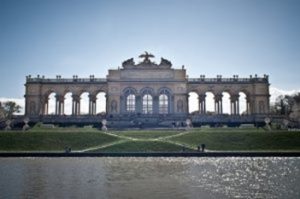
Vienna
The Habsburg Dynasty was one of the most powerful forces in Europe for centuries, its rule extending across several different Kingdoms at various points in time. Until its dissolution in 1780, the Dynasty served at the head of the Holy Roman Empire. Following Charles V’s death, the dynasty was divided between Spanish and Austrian branches, which maintained close links despite independence. Following this separation in the mid-16th Century, the Spanish Habsburgs gradually deteriorated. Historians believe this was partially a result of excessive inbreeding. The Spanish Habsburgs attempted to consolidate its shaky grip on power through marriages within the family, which had a significantly detrimental effect on the gene pool. This culminated with Charles II, otherwise known as ‘The Bewitched’ due to his physical and mental disabilities. His ineffective rule significantly weakened the Habsburg’s grasp on power, and after dying without issue, the War for the Spanish Succession ensued.
Coming Of The Bourbons
The War for the Spanish Succession lasted 13 years and involved many of Europe’s major powers. Charles II’s death without issue triggered a lengthy debate over who would rightfully inherit his Empire and its holdings. Peaceful talks between the Royal Houses of Habsburg, Bourbon and Wittelsbach deteriorated into outright conflict. Although Charles II left his Empire to his grandnephew Philip V, himself the grandson of King Louis XIV, many rival powers feared the House of Bourbon’s growing power. Austria, England and the Dutch Republic, in an attempt to quell the power of the French, supported the Holy Roman Emperor Leopold I’s claim to the throne for his second son Charles VI. The ensuing conflict resulted in Philip V, and thus the House of Bourbon assuming control of the Spanish Empire albeit with significant concessions. Philip V renounced his claim to the French throne, thereby preventing the Empire’s hegemony over Europe.
Furthermore, the Spanish Empire ceded several key territories within its Empire to various powers, including the Spanish Netherlands, the Duchy of Milan, Sardinia and the Kingdom of Naples to the Austrian Habsburgs and Gibraltar and Menorca to Britain.
The House of Bourbon thus assumed control over the Spanish Crown, which it still maintains in the present day. However, its grasp on power has been regularly destabilised over the past 300 years. Philip’s reign was beset with residual issues and conflicts from the final years of Habsburg rule, exacerbated by his aggressive foreign policy. His successors’ tenures as rulers were generally less eventful, with sporadic conflicts occurring up until the next major power shift during the Napoleonic Wars.
The Napoleonic Wars & The End Of The Empire
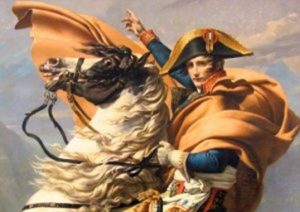
Napoleon Bonaparte by Jacques-Louis David
The Spanish Empire’s decline coincided with the beginning of the 19th Century. The crown’s close ties with France and its new leader Napoleon Bonaparte played a critical role in this. The Empire notably lost the vast Louisiana Territory, ceded to the French and sold to the United States as part of the Louisiana Purchase. Having reached its territorial apex in 1790, the Spanish Empire’s holdings oversea began to decline rapidly. The Empire’s closeness with France ensured its involvement in Napoleon’s military endeavours. During the Battle of Trafalgar, the Spanish Empire’s Naval Fleet was completely decimated, significantly undermining its ability to maintain order in its overseas colonies. This caused Spanish-French relations to deteriorate further. These tensions reached a head during the Peninsular Wars, wherein the joint invasion of Portugal in 1807 ended up seeing Napoleon turn on the Spanish Empire. Additionally, Napoleon forced the abdication of the Spanish King, installing his brother Joseph Bonaparte in his place.The conflict was costly on both sides, depleting Napoleon’s resources and ultimately the Allies emerged victorious. However, the remnants of the Spanish Empire were left in a state of complete discord, with the power vacuum leading to years of dispute between the various Juntas. These internal disputes resulted in the Empire losing control of its many overseas territories.

